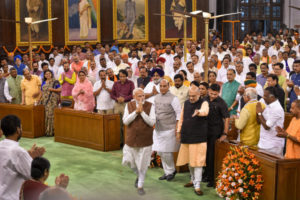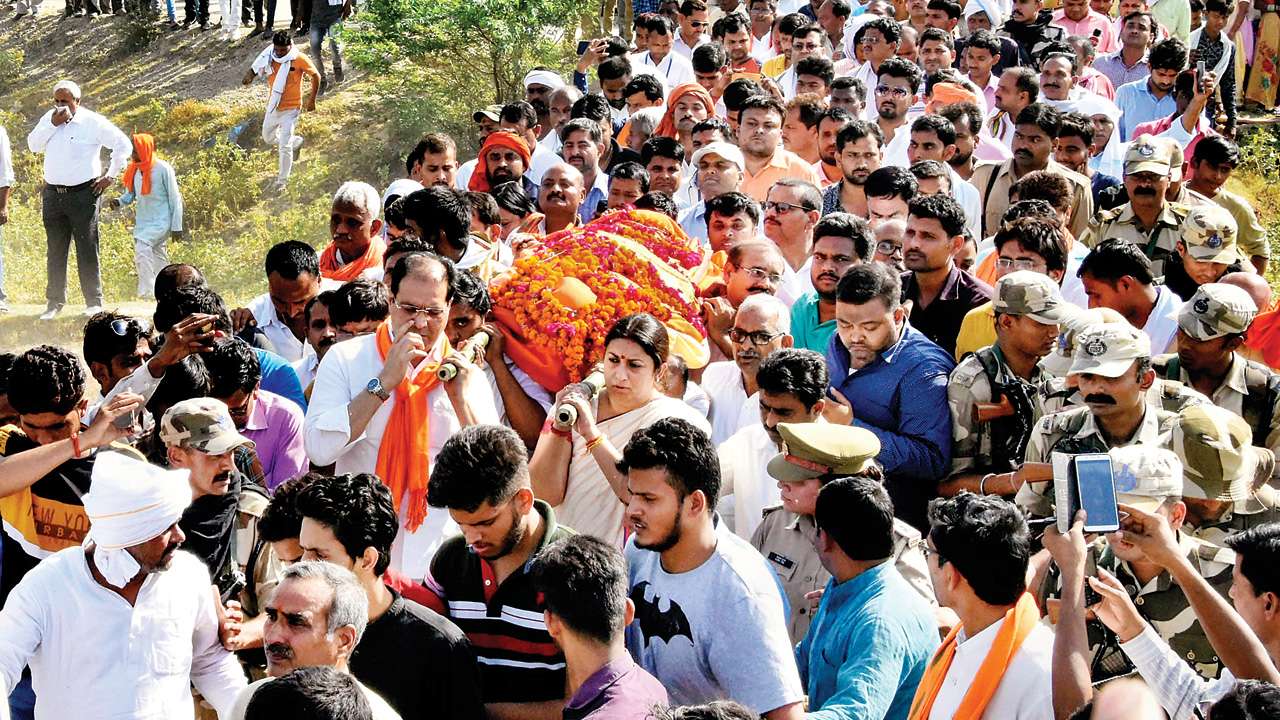A country which had a woman prime minister for 15 years has managed to put a measly 78 women in the Lok Sabha this time. Only Bengal’s TMC and Odisha’s BJD made a conscious effort to boost the numbers
For those interested in gender issues, three standout images on TV after the poll results were reminders of women’s status in the political scenario:
l On May 25, at the NDA parliamentary board meeting in the central hall of Parliament that elected Narendra Modi for a second term as PM, in the front row you saw the sari-clad Maneka Gandhi and the pink-suited Harsimrat Kaur Badal. When the camera panned over the other sitting (literally) MPs, the viewer could see that there was only a scattering of women, too few to really count as a major political force (78 out of 543). It was a moment of triumph for them individually and for the parties which had faith in their winnability. But it was also a visual repudiation of the fact that half of India’s population is considered half as important as men.
l On May 26, the very next day, viewers saw Smriti Irani putting her shoulder to the bamboo bier of her slain Amethi aide, Surendra Singh. It was startling, as no woman has been seen doing that before. Half a century ago, it was not customary for women to attend cremations. They do now, but we still don’t see a woman lighting the funeral pyre unless a daughter insists on it. While the world lauds Smriti Irani for having defeated none less than the Congress party president in his own domain, she deserves another feather in her cap for defying a taboo and breaking a gender
barrier.
l In Lucknow, again on TV, you could see a group of divorced Muslim women getting together to celebrate the NDA’s victory. One of them was beating a drum while another boldly faced the camera to thank the prime minister for passing the Triple Talaq bill (which was not passed by the Rajya Sabha and is right now a lapsed ordinance). It was a surprising image, like that of Irani in Amethi.
So where do women stand, after the May 2019 general elections? The numbers show steady — but exasperatingly slow — progression in the number of women MPs in the Lok Sabha, way behind the kind of strides women have been taking in other fields. We had 45 women MPs out of 543 in 2004, 58 in 2009, 63 in 2014 and now there are 78, which is only 14%.
If India lags behind other South Asian countries in this matter, we have only past Parliaments to blame, as the bill proposing 33% reservation for women never saw the light of day, whereas our neighbours already have quotas allocated for women: Afghanistan (25%) since 2005, Pakistan (20%), Nepal (28%), and Bangladesh (13%). In the UK, where there is no quota, 210 out of 650 MPs in the House of Commons are women (32%), up from 143 nine years ago.
The magic figure of 33% is considered by global political analysts as necessary for a ‘critical mass’ which can make a difference to a nation’s policy formulation.
While the Bharatiya Janata Party did not demonstrate much faith in women — despite its ability to get candidates elected on Modi’s name — the two regional parties in the east, the Trinamool Congress and Biju Janata Dal (BJD), were extremely generous in handing out tickets to women. Mamata Banerjee, a self-made politician who became Bengal’s first woman Chief Minister, and has already served a term at the Centre as MP and Railway Minister, was way ahead of others.
No less than 41% of TMC candidates for West Bengal’s 42 seats — a total of 17— were women. Four were popular actresses who were mercilessly trolled, reminding us why few women are ready to step into the arena unless they have solid family support. Nine of the TMC women candidates won, which is one more than even the women MPs from UP, the state from which eight out of 10 women fielded by the BJP triumphed.
In a similar vein, putting women’s rights in the spotlight, Odisha CM Naveen Patnaik announced that his party was giving 33% tickets to women candidates. With a total of 21 seats in the Lok Sabha, the BJD fielded seven women, out of whom five won. Two of them are former civil servants, one is a doctor, one comes from a farming family, and the youngest, at 25, has an engineering degree. No dynasts here.
But the debate about dynasts has been louder than ever in this election, not least because of Priyanka Gandhi Vadra’s sudden appearance as a charismatic campaigner. We must not lose sight of the fact that many women MPs come from political families — and were obediently following orders of the patriarchs, rather than nurturing any real ambition themselves.
In fact, there is nothing terribly feminist about the choice of women candidates in other states. In a scathing post, political analyst Prakash Nanda comments, “Women candidates are more ‘dynastic’ than male candidates. Parties tend to select their women candidates from within existing political families, as they still perceive that fielding women candidates constitutes a risk. As a result, 100% of the female candidates fielded by the SP, the TDP, the DMK and the TRS belong to political families. In smaller parties, they also tend to be directly related to the party leader. For the RJD, the three women candidates fielded are wives of jailed party goondas.”

In this context, the BJP does not come out smelling of roses either. The party, in its latest manifesto, again made a promise of passing the bill for 33% representation for women, but gave tickets to only 53 women candidates, of whom 34 made it to the Lok Sabha. Some prominent names were repeats: Hema Malini, Meenakshi Lekhi, Maneka Gandhi, Kirron Kher and 11 others. Dynasts like Rita Bahuguna Joshi and Sangeeta Singh Deo (who won from Balangir for the fourth time) are well known but the newcomers, whose names are unfamiliar, have interesting back stories which the media is discovering one by one.
A passing glance at women losers throws up some household names: Mehbooba Mufti, Dimple Yadav, Poonam Sinha, Jayaprada, Moon Moon Sen, Priya Dutt and Urmila Matondkar. Mufti lost because of her alliance with the BJP but the others are lightweights, never having bothered to build a political profile of their own.
If sheer numbers count, a total of 715 women, including Independents, jumped into the fray — which is one-tenth the number of 7,334 male candidates. So if they are now 14% of the total strength of the Lok Sabha, their strike rate has been proportionally more than their candidature. These are the encouraging signs on which hope can be hung.
Moreover, if public sentiment continues to solidify against dynasts, parties would need to go on a talent hunt to find possible winners in the next round of general elections.





